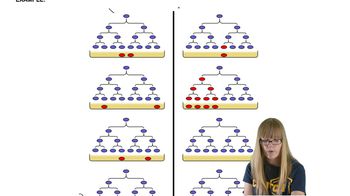What is the physical state of DNA after it is heated and denatured?
Table of contents
- 1. Introduction to Genetics51m
- 2. Mendel's Laws of Inheritance3h 37m
- 3. Extensions to Mendelian Inheritance2h 41m
- 4. Genetic Mapping and Linkage2h 28m
- 5. Genetics of Bacteria and Viruses1h 21m
- 6. Chromosomal Variation1h 48m
- 7. DNA and Chromosome Structure56m
- 8. DNA Replication1h 10m
- 9. Mitosis and Meiosis1h 34m
- 10. Transcription1h 0m
- 11. Translation58m
- 12. Gene Regulation in Prokaryotes1h 19m
- 13. Gene Regulation in Eukaryotes44m
- 14. Genetic Control of Development44m
- 15. Genomes and Genomics1h 50m
- 16. Transposable Elements47m
- 17. Mutation, Repair, and Recombination1h 6m
- 18. Molecular Genetic Tools19m
- 19. Cancer Genetics29m
- 20. Quantitative Genetics1h 26m
- 21. Population Genetics50m
- 22. Evolutionary Genetics29m
7. DNA and Chromosome Structure
DNA as the Genetic Material
Problem 31b
Textbook Question
A primitive eukaryote was discovered that displayed a unique nucleic acid as its genetic material. Analysis provided the following information:
A major hyperchromic shift is evident upon heating and monitoring UV absorption at 260 nm.
 Verified step by step guidance
Verified step by step guidance1
Step 1: Understand the concept of a hyperchromic shift. In nucleic acids, a hyperchromic shift refers to an increase in UV absorbance at 260 nm when the double-stranded structure denatures into single strands upon heating. This is because single-stranded nucleic acids absorb more UV light than double-stranded forms.
Step 2: Recognize that the presence of a major hyperchromic shift upon heating suggests that the genetic material has a double-stranded structure that can denature, similar to DNA or double-stranded RNA.
Step 3: Consider the types of nucleic acids that exhibit hyperchromic shifts. Double-stranded DNA and double-stranded RNA both show this property, while single-stranded nucleic acids show less or no hyperchromic shift upon heating.
Step 4: Use the information about the hyperchromic shift to infer the nature of the nucleic acid. Since the primitive eukaryote's genetic material shows a major hyperchromic shift, it likely contains a double-stranded nucleic acid.
Step 5: To further characterize the nucleic acid, additional experiments such as enzymatic digestion, base composition analysis, or molecular weight determination could be performed to distinguish between DNA and RNA or identify any unique features.
 Verified video answer for a similar problem:
Verified video answer for a similar problem:This video solution was recommended by our tutors as helpful for the problem above
Video duration:
2mPlay a video:
Was this helpful?
Key Concepts
Here are the essential concepts you must grasp in order to answer the question correctly.
Hyperchromic Shift
A hyperchromic shift refers to an increase in UV absorption at 260 nm when nucleic acids denature, indicating strand separation. This phenomenon is commonly used to study the melting behavior of DNA or RNA, as single strands absorb more UV light than double-stranded forms.
Recommended video:
Guided course

Spontaneous Mutations
Nucleic Acid Structure and Types
Nucleic acids, primarily DNA and RNA, differ in structure and function. DNA is typically double-stranded with deoxyribose sugar, while RNA is usually single-stranded with ribose. Understanding these differences helps interpret unusual genetic materials in organisms.
Recommended video:
Guided course

Ribosome Structure
UV Absorption of Nucleic Acids
Nucleic acids absorb UV light maximally at 260 nm due to their aromatic bases. Monitoring UV absorption changes during heating reveals information about nucleic acid stability and conformation, essential for identifying the nature of genetic material.
Recommended video:
Guided course

Point Mutations

 9:32m
9:32mWatch next
Master History and Experiments with a bite sized video explanation from Kylia
Start learningRelated Videos
Related Practice
Textbook Question
560
views
